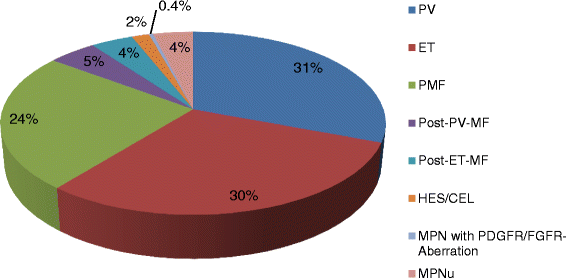Bleeding, thrombosis, and anticoagulation in myeloproliferative neoplasms (MPN): analysis from the German SAL-MPN-registry
- PMID: 26944254
- PMCID: PMC4779229
- DOI: 10.1186/s13045-016-0242-9
Bleeding, thrombosis, and anticoagulation in myeloproliferative neoplasms (MPN): analysis from the German SAL-MPN-registry
Abstract
Background: Patients with Ph-negative myeloproliferative neoplasms (MPN), such as polycythemia vera (PV), essential thrombocythemia (ET), and primary myelofibrosis (PMF), are at increased risk for thrombosis/thromboembolism and major bleeding. Due to the morbidity and mortality of these events, antiplatelet and/or anticoagulant agents are commonly employed as primary and/or secondary prophylaxis. On the other hand, disease-related bleeding complications (i.e., from esophageal varices) are common in patients with MPN. This analysis was performed to define the frequency of such events, identify risk factors, and assess antiplatelet/anticoagulant therapy in a cohort of patients with MPN.
Methods: The MPN registry of the Study Alliance Leukemia is a non-interventional prospective study including adult patients with an MPN according to WHO criteria (2008). For statistical analysis, descriptive methods and tests for significant differences as well as contingency tables were used to identify the odds of potential risk factors for vascular events.
Results: MPN subgroups significantly differed in sex distribution, age at diagnosis, blood counts, LDH levels, JAK2V617F positivity, and spleen size (length). While most thromboembolic events occurred around the time of MPN diagnosis, one third of these events occurred after that date. Splanchnic vein thrombosis was most frequent in post-PV-MF and MPN-U patients. The chance of developing a thromboembolic event was significantly elevated if patients suffered from post-PV-MF (OR 3.43; 95% CI = 1.39-8.48) and splenomegaly (OR 1.76; 95% CI = 1.15-2.71). Significant odds for major bleeding were previous thromboembolic events (OR = 2.71; 95% CI = 1.36-5.40), splenomegaly (OR = 2.22; 95% CI 1.01-4.89), and the administration of heparin (OR = 5.64; 95% CI = 1.84-17.34). Major bleeding episodes were significantly less frequent in ET patients compared to other MPN subgroups.
Conclusions: Together, this report on an unselected "real-world" cohort of German MPN patients reveals important data on the prevalence, diagnosis, and treatment of thromboembolic and major bleeding complications of MPN.
Figures


Comment in
-
Long-standing thrombocytosis often precedes thromboembolic complications heralding the diagnosis of essential thrombocythemia.Eur J Intern Med. 2023 Jan;107:110-112. doi: 10.1016/j.ejim.2022.09.002. Epub 2022 Sep 15. Eur J Intern Med. 2023. PMID: 36117085 No abstract available.
References
-
- Swerdlow SH, Campo E, Harris NL, Jaffe ES, Pileri SA, Stein H, et al. WHO classification of tumours of hematopoietic and lymphoid tissue. Lyon: IARC; 2008.
Publication types
MeSH terms
Substances
LinkOut - more resources
Full Text Sources
Other Literature Sources
Medical

